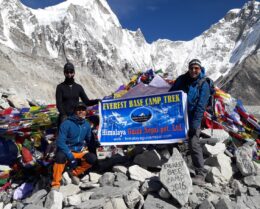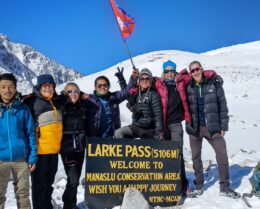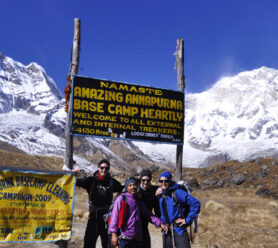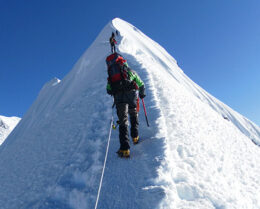Things to know about Island Peak (Imja Tse )
UPDATED ON 4 March, 2024
This is all the information you want to summit Nepal’s most well-known peak at above 6,000 meters. By following our advice, our clients have been able to successfully enjoy themselves while reaching the Island Peak summit.
When is the best time to climb Island Peak?
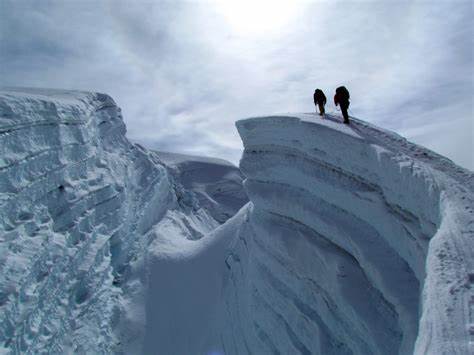
Most climbers find that the optimum times to summit Island Peak are in the spring (March–May) or fall (Mid-September–October) of any given year. The Himalayan region and the majority of Nepal get consistent weather during these times, making them ideal for adventurous activities.
The majority of 8,000+M treks in the Everest region take place in the spring, so expect a throng of hikers on the paths. However, as most people using the trails are there for trekking, you will notice a sharp decline in population once you arrive at your Island Peak camping location.
Although it is still feasible to climb in the winter, we only advise people who have nearly professional levels of mountaineering competence. The weather is severe and the temperature is low. There may be temperatures as low as -25 or -30 C and winds as high as 60 mph.
Are guides required to climb Island Peak?
We do not advise climbing in the Himalayas without the assistance of Sherpa guiding guides unless you are a certified mountain guide. It will be necessary for you to traverse the crevasse holes while wearing crampons and support ladders. Utilizing ascenders is necessary for the last, 90-degree vertical ascent that leads to the peak.
Reaching the summit is not the only goal of peak climbing. It is also necessary to take into account the work involved in properly descending back, which can be just as taxing because it calls for all of your concentration. To go from the peak down below, you will need to utilize either an ATTC or a figure 8 gear.
Pre-tour gratuities are obligatory and include summit bonuses, tips for all climbing staff, porters, assistant guides, drivers for airport transportation, hotel security, and assistance.
We divide up these tips equitably among the members according to the type and volume of work they have completed. Furthermore, guests are free to leave additional, personalized tips if they so like.
What kinds of food are offered when climbing Island Peak? Is there clean water available, and what is the recommended daily water intake?
All of our clients are advised to drink four to six liters of water each day. Maintaining sufficient hydration will aid in your correct acclimatization as well. It is advisable to carry filtration bottles or hydration tablets.
Tea rooms cook the majority of the food, and our Sherpa teams will set up kitchen tents during your climbing days. Food is not a concern for you, but always remember to eat plenty of it.
Despite the bitterly cold conditions, your body will instinctively desire to reject meals at high elevations or avoid utilizing energy for anything, even eating. After the first few bites, you may need to push yourself, but ultimately your body will begin to accept the meal.
In case our guests decide they do not want to consume the food being cooked in the tents, we also provide packaged dehydrated meals.
Recall to abstain from all alcohol and smoking. Though our guiding leaders may appear to be smoking or drinking, keep in mind that they are experts who have adapted far better to these conditions than climbers who visit on adventure-seeking vacations.
How much time do hikers and climbers spend each day?
On typical hiking days, you will travel 10–14 km in 5–6 hours each day. However, it is advisable to climb as slowly as possible, utilizing the appropriate amount of energy for the lengthy duration and breathing in as much air as possible, your climb may take up to eight or nine hours on the day of the summit.
What kind of preparation is needed to summit Island Peak?
Despite being rated as a beginner’s climb, Island Peak is by no means an easy climb. Mountains are ranked according to their physical and technical challenges. It is quite difficult to simulate using ladders for your training that are similar to the ones you will encounter when navigating the crevasse.
We strongly advise concentrating on strength and endurance training. Any kind of aerobic exercise is recommended, including climbing uphill with weights weighing 10–15 kg, cycling for one to two hours, and long-distance jogging (10–15 km) three to four times a week.
Tips for Island Peak Climbing
Acquire previous high-altitude experience
It certainly helps to have prior high-altitude experience. It is not necessary to plan for adequate acclimatization, but it will undoubtedly help to have some prior experience at high altitudes. Take a hike that ascends to 5000 meters above sea level and pick up some fundamental mountaineering techniques because Island Peak requires more than you may have imagined.
Before the actual climb, we provide a climbing course at the base camp where you can acquire the necessary climbing abilities. Thus, it is quite advantageous to undertake a high-altitude climb before reaching the Island summit.
Learn the fundamentals of mountaineering
A steep slope necessitates the use of climbing equipment (harnesses, fixed ropes, abseil devices, etc.) for Island Mountain, which is not your typical trekking mountain. It will undoubtedly put your mountaineering abilities to the test and enhance them.
It helps to have some basic mountaineering skills. We have set aside a day specifically for the climbing course on our Island peak climb. Together with your climbing guide, you can acquire the fundamental abilities needed to reach the top at Chukung or the base camp.
Arrive mentally prepared
You’ve prepared yourself physically and in every way, but how strong is your mind? It is just as crucial as getting physically ready. It takes mental preparation to successfully climb Island Peak since, in the end, mind over body prevails. Arrive psychologically prepared, and avoid approaching the goal with excessive self-assurance. Get yourself ready for the chilly weather, a strenuous walk, and dyspnea.
Cut the cable if you can, and give the climb your whole attention and dedication. Maintaining regular contact with loved ones, coworkers, or the outside world while climbing can cause you to lose focus, which reduces the likelihood that your ascent will be successful.
Give yourself enough time to acclimate on your trip
Allow the altitude to adjust to your body. To properly acclimate to your itinerary, we highly advise combining the Island Peak Climb with the Everest Base Camp & Kalapathar. You will be traveling for an additional three to four days, but it will all be worthwhile.
To increase your chances of reaching the summit, climb Kalapathar (5545m) and Everest base camp before moving on to Island Peak. Many people choose to go directly to Island Peak, which shortens the climb’s overall duration.
Train well ahead
It will be a more pleasurable experience the more fit you are. You must be in excellent physical shape for the several days of high-altitude walking to the base camp and the ten to twelve-hour summit push. Train well in advance, ideally three to four months before you take the route. Develop your strength, climbing techniques, and cardiovascular fitness in preparation for the ascent.
Regular hiking with moderate weight and cardiovascular exercise will increase your stamina. Start your Island Peak preparation with general conditioning and work your way up to the specific training needed for the ascent.
Retain a contingency day
Anything might cause an itinerary to change while on the mountain, so it’s always a good idea to include a contingency day. The schedule may need to be altered due to a variety of unanticipated events (health, weather, route, etc.), so having a backup day will keep your itinerary intact. If all goes according to plan, you can use today to relax, remember your climbing experiences, or even reward yourself with something nice.
Steer clear of winter winds and spring snowfall
Because of the heavy snow and extremely cold (-40C) winds at the peak, we often don’t run the climb between December and mid-February. If there is a lot of fresh snow on the summit, it might be challenging even in the early spring months of February and March.
During the peak season, which runs from March to May and September to November, Island Peak sees a significant number of climbers (around 80 per day), therefore it normally takes only a few days for the route to become packed down and accessible again.
The summit and headwall of Island Peak
After leaving High Camp, you have to climb a steep valley to get to the glacier’s beginning, where you must put on your crampons. The last steep ascent up the headwall before reaching the summit ridge is perhaps the hardest part of the climb. The actual headwall is a 300-meter ascent with a 40–50 degree slope. To begin the ascent, your climbing Sherpa will have you rope up.
Some Similar posts

